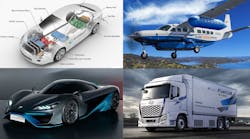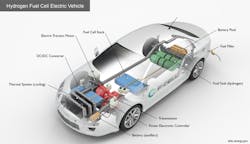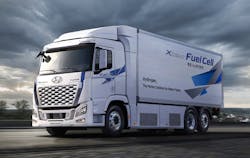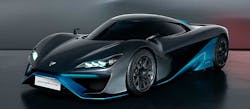Industry Pushes to Add Hydrogen to the Zero-Emissions Mix
This article is part of the TechXchange: EV Battery Management
Members can download this article in PDF format.
What you'll learn:
- The functionality of a hydrogen fuel cell.
- What's holding back widespread adoption of hydrogen technology?
- The latest advances in the hydrogen fuel-cell tech for EVs.
- The potential impact of hydrogen in aviation.
Introducing a game-changing element is something like a golfer scoring a hole in one. This event happens relatively infrequently, yet everyone knows there’s another one coming, but it’s not known exactly when or by whom.
The same can be said for future emission-free vehicles. While no one will deny that battery-powered vehicles (BEVs) are the front-runner in the fight against climate change, EVs may not be the only bright hope in this struggle. An increasing number of industry-watchers believe all-electric vehicles, about 2.5 million of which have been sold in the U.S., are one solution, but not the solution. Indeed, when it comes to the challenge of achieving zero carbon emissions, there may not be a one-size-fits-all solution.
A second centerpiece in the effort to reduce the greenhouse-gas and air-quality impacts of transportation systems is hydrogen. Advances in hydrogen-powered vehicles are being driven by the fact that the transportation industry is the single largest source of greenhouse-gas emissions in the U.S. A recent study by Juniper Research predicts that the number of hydrogen vehicles in service globally will exceed 1 million by 2027 vs. just over 60,000 in 2022.
To recap: Hydrogen is a colorless, odorless, flammable gas that already powers some cars, trucks, buses, and trains. In a fuel-cell EV, energy stored as hydrogen is converted to electricity while producing no harmful tailpipe emissions.
A hydrogen fuel-cell vehicle uses the same kind of electric motor to turn the wheels as a BEV. But instead of being powered by a large, heavy battery, it employs a fuel-cell stack in which hydrogen passes through an electrolyte membrane sandwiched between a positive electrode (cathode) and a negative electrode (anode). Negative hydrogen particles are split off, which creates a flow of electrons—electricity—to power the motor. After that, all of the particles reunite (hydrogen and oxygen) producing water, which is the only emission.
Still, some environmentalists are skeptical of hydrogen fuel because most commercially produced hydrogen in the U.S. comes from natural gas. In the process, it emits greenhouse pollutants carbon dioxide and methane that contribute to global warming. This type of hydrogen is called grey hydrogen.
Another method of production uses electrolysis, with an electric current splitting water into oxygen and hydrogen. If the electricity used in this process comes from a renewable source, such as wind or solar, then it’s called green or renewable hydrogen.
The third major source, known as blue hydrogen, comes from fossil fuels. However, the CO2 is captured and stored, so it’s generally considered to be carbon neutral.
Hydrogen Fuel-Cell Vehicles
Since 2015, three hydrogen-powered cars have been offered for sale: the Honda Clarity Fuel Cell, the Hyundai Nexo SUV, and the Toyota Mirai. Honda has now ended production of all models of the Clarity (which was only available for lease and not purchase) and Hyundai has sold fewer than 1,500 of two generations of Nexo SUVs.
Toyota has done somewhat better, selling nearly 11,000 Mirai sedans across in the U.S. In 2021, Toyota registered the highest sales for the Mirai with 2,629 units, more than a 400% increase over 2020’s sales figures
One of the more important factors supporting hydrogen-based vehicles is that drivers can refill their vehicles' carbon-fiber high-pressure tanks at hydrogen fueling stations very similar in concept to current gas stations. They can be filled up with a nozzle almost as quickly as traditional gas and diesel vehicles, about five minutes for a 300- to 400-mile range.
But a shortage of fueling stations is limiting hydrogen’s appeal. Fewer than 100 retail hydrogen refilling stations exist in the U.S. By comparison, more than 100,000 fuel stations are available nationwide for gasoline cars.
The U.S. Department of Energy (DoE) has earmarked $7 billion to establish up to 10 regional hydrogen hubs. The department plans to select at least four regional hubs, with at least one from “green” hydrogen produced by renewable energy; one from “blue” hydrogen sourced from natural gas and using carbon capture and storage; and one “pink” hydrogen project from nuclear power.
Hydrogen fuel-cell vehicles (Fig. 1) are considered as safe as any other car since the high-pressure carbon-fiber tanks are designed to hold pure hydrogen at a pressure of 10,000 pounds per square inch (psi) and can survive even a high-speed crash without leaking. The service life of fuel cells is comparable to that of other vehicles: the polymer-electrolyte-membrane fuel cell’s service life is estimated to be about 7,300 hours.A big concern hampering EV technology from scaling up to become commercially viable for anything larger than small trucks is battery weight. So, while batteries work well for light duty applications, such as urban package delivery vans, fuel cells may prove to be better for use in Class 8 heavy-duty trucks operating on interstate highways (Fig. 2).
Latest Advances
To that end a zero-emissions product revealed recently by Cummins, whose products range from diesel and natural gas engines to hybrid and electric platforms, is the company’s fourth-generation hydrogen fuel-cell engine. Designed to meet the duty-cycle, performance, and packaging requirements of medium- and heavy-duty trucks and buses, the fuel-cell technology is available in 135-kW single and 270-kW dual modules.
Looking ahead, Scania in Europe and Daimler Trucks North America have each announced collaboration with Cummins to develop and integrate these next-generation fuel-cell engines into demonstrator vehicles. The systems use variable pressure technology to provide higher power density, power nodes, and operating temperatures for easier system integration into vehicles.
The recently unveiled Apricale hypercar runs on hydrogen (Fig. 3). The powertrain is complemented by a motorsport-inspired chassis, and a body built by Pininfarina. In what it says is a first, Apricale’s Tri-Volt technology means that both the fuel cell and the battery can power the car in any combination.
Typical modes that can change in milliseconds include:
- At low speed and around town, the car is driven by the battery.
- At steady speed, the fuel cell drives the wheels directly.
- For full acceleration, or driving on a track, the battery and the fuel cell are combined.
Tri-Volt requires a far smaller battery (about 10% of the size of a typical BEV battery pack), which means the powertrain has the same weight as a gasoline equivalent. The total deployable power is 800 kW, equivalent to over 1,000 bhp.
The Million Mile Fuel Cell Truck (M2FCT) consortium, a DoE-funded group formed by five primary national labs, aims to advance the efficiency and durability of polymer-electrolyte-membrane, or PEM (also referred to as “proton exchange membrane”), fuel cells through an initial focus on long-haul trucks. While cars only have to travel 200,000 miles in their lifetime, long-haul trucks must cover 1 million miles. This initiative is a five-year project that includes manufacturers such as General Motors, Nikola Corp. and Plug Power Inc.
Toyota Motor North America and Kenworth Truck Company report they have proven the capabilities of their jointly designed, heavy-duty, Class 8 fuel-cell electric vehicles (FCEVs) as a potential zero-emissions replacement of diesel-powered trucks. This comes on the heels of the completion of their operations in the Zero- and Near-Zero Emissions Freight Facilities (ZANZEFF) “Shore to Store” project.
The baseline for the Toyota-Kenworth T680 truck—codenamed “Ocean”—was a 2017 diesel engine operating about 200 miles a day. The T680 has a range of about 300 miles when fully loaded to 82,000 lbs. and with no downtime between shifts for charging. Together with its short 15- to 20-minute fill time, the trucks could run multiple shifts a day and cover up to 400 to 500 miles.
Kenworth designed and built the Class 8 T680, while Toyota designed and built the powertrain’s fuel-cell electric power system powered by hydrogen. The Ocean trucks were said to reduce greenhouse gases by 74.66 metric tons of CO2 per truck annually compared to the baseline diesel engine.
The success of the 10 trucks in serving real-world customers was a result of close collaboration among project members, including Kenworth, Toyota, the Port of Los Angeles as the project lead, Shell for hydrogen fuel infrastructure, and a grant from the California Air Resource Board (CARB). Shell built a total of three hydrogen stations, the first public provider in California to fuel heavy-duty trucks. Toyota plans to produce fuel-cell powertrain modules at Toyota Motor Manufacturing Kentucky in 2023.
Battery-electric, internal combustion engines (ICEs) are another viable way to power a vehicle with hydrogen. Hydrogen ICE engines can achieve the same outcomes as fuel cells in terms of reducing greenhouse-gas emissions, but they require a smaller upfront investment.
For an original equipment manufacturer (OEM), current vehicles can be redesigned to host a hydrogen engine without major changes to the driveline, transmission, brakes, or chassis. The most intensive modification to the vehicle’s architecture in the redesign phase may be the addition of a hydrogen fuel system.
Meeting Aviation’s Energy Demand
There’s also growing interest in aviation applications, as hydrogen power has great potential to speed air travel toward net-zero carbon emissions. Aviation accounts for about 2.5% of global greenhouse-gas emissions every year. Utilizing hydrogen, either through combustion or via a fuel cell, can eliminate most pollutants associated with jet fuel, which include carbon monoxide, carbon dioxide, nitrogen oxide, and unburned hydrocarbons.
According to industry estimates, about one-third of total passenger traffic worldwide could be carried by planes burning liquid hydrogen, based on 2019 route data. Studies also have shown that by 2050 “green hydrogen”—produced using renewable electricity—could reduce total emissions from passenger flights by 31%.
Delta and Airbus have signed a Memorandum of Understanding to collaborate on research to accelerate the development of a hydrogen-powered aircraft. Under the agreement, Delta will provide the operational and infrastructure requirements needed to develop commercial aircraft powered by hydrogen fuel.
Two key areas of focus will be:
- Aircraft concept: The technical and economic viability of hydrogen-fueled aircraft, identifying the pathway for introduction into Delta’s fleet and operations, as well as the aircraft’s potential performance in Delta’s fleet. That includes identifying challenges such as flight range limits, refueling time, and airport compatibility.
- Aviation ecosystem: Assessing the infrastructure that will be needed to develop green hydrogen, bring it to scale, and implement at airports nationwide, as well as analyzing regulation and costs, to identify a clear path for progress ahead.
In February, CFM and Airbus announced they’re collaborating on a hydrogen demonstration program with plans to flight test a hydrogen combustion engine around the middle of this decade. The objective is to ground and flight test a direct combustion engine fueled by hydrogen in preparation for entry into service of a zero-emission aircraft by 2035.
Airbus itself will test a hydrogen-powered demonstration engine on one of its A380 jets. When flight tests begin around the mid-2020s, the modified engine mounted on the rear top of the fuselage of the A380 will allow the company to test the modified hydrogen-powered engine’s emissions and monitor them separately.
Engineers at GE Aviation and Safran Aircraft are working to modify a GE Passport jet engine to operate on hydrogen fuel. This includes a complete overhaul of its combustor, fuel system, and controls system to make them compatible with liquid hydrogen. The group picked the Passport because of its size, advanced turbomachinery, and ability to operate at the appropriate pressures and temperatures for flight.
California-based ZeroAvia this summer completed the first test flight of a six-passenger airplane powered solely by a hydrogen fuel cell, which converted hydrogen into electricity to drive the propellers (Fig. 4). The Piper Malibu flew for eight minutes on fuel-cell power alone, reaching a height of 1,000 feet and an airspeed of 100 knots (115 mph).
Future aviation systems will have to solve a thorny problem: Storing gaseous hydrogen on board requires too much volume. Because H2 naturally exists as a gas, it will need to be stored in liquid form, which means cooling it to about −253°C (−423°F). The liquid hydrogen will then need to be vaporized into gas to be used as fuel. As a result, parts of the engine could see temperature differences of 1,500°F or more. In addition, because aviation would need liquid hydrogen (LH2), transportation would have to be optimized for LH2.
Read more articles in the TechXchange: EV Battery Management




